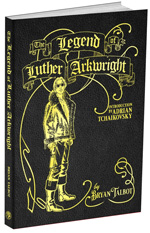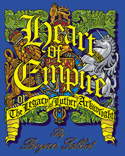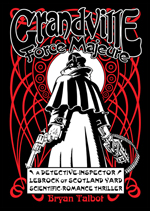Michael Moorcock's Introduction to the Adventures of Luther Arkwright
This is the introduction written by Michael Moorcock for the Dark Horse edition of the complete trade paperback edition of the Adventures of Luther Arkwright, and is copyright 1997 by Michael Moorcock.
There's something solid and Northern English
about a name like Arkwright
It suggests a man with his feet on the ground, prepared to look facts in the face and to do something about them if he has to. Luther, on the other hand, suggests a foreign quality, even a exotic, slightly visionary tinge which would once have been a little disturbing to the average inhabitant of the Lancashire mill towns.
Nowadays, of course, those old weaving towns, which gave the Northern industrial landscape its character, no longer have the same stereotypical image. Be-shawled and be- clogged, shuffling at dawn over the hard cobbles to the factory gates, the workers were the epitome of ground-down wage-slaves. They took the brunt of the "Hungry Thirties."
Nowadays, when they have jobs at all, the workers are much more exotic. They may well still be the epitome of wage slavery, but they wear saris and turbans, and many speak Bengali as their first language. Even Mr. Gradgrind the mill owner is probably now called Mrs. Patel. The average inhabitant of the mill towns is as likely to worship at a mosque or a Hindu temple and still think of the Indian sub-continent as the motherland. The British Empire, in miniature, came home. Britain went from being the hub of the largest and most widespread imperium the world had ever known to a small, crowded nation that had become, almost overnight, multi-ethnic. It was a bit of a shock to the average native.
The conscious and often principled dismantling of the Empire which happened rapidly after 1946, with the coming to Parliament of the first great socialist government, was accompanied by a shortage of manpower caused by the Second World War. Citizens of the British Commonwealth, mostly from the West and East Indies, were encouraged to emigrate to the United Kingdom to fill the thousands of jobs - most of them low paid - which were urgently available.
After South Africa left the Commonwealth over the issue of apartheid, many South Africans also arrived, together with Nigerians and Ghanians. Frequently idealistic about the "mother country," they found prejudice, wretched exploitation, poverty, and a climate which, if you weren't born to it, can suck the soul from your eyes.
The absorption of these new cultures into the host culture was not as dramatic as some predicted (Enoch Powell, the "intellectual fascist" of the Tory Party warned that racial conflict would bring "rivers of blood" to Britain) and from the beginning there were people dedicated to the cause of social justice who, myself amongst them, eventually saw some of their idealism formalised in the Race Relations Act which made active prejudice, racial slurs and the like, illegal.
Alone, no such act ever changes society, and it did nothing to convince the skinheads and crypto-Nazis, but it does set the standard to which that society aspires. It says that the active expression of racial prejudice is unacceptable in a civilised world. Framed when memories of the Goebbels years were much fresher, the act certainly had respect for words and pictures. It admitted that they could kill.
In England, it did not stop the sentiently challenged from abusing and attacking Pakistani women and children or beating up old black men or kicking a boy to death, but it did give the victims some means of restitution, and it told them that they had specific recourse to the law. Of course it didn't stop racist policemen ignoring complaints (or indeed compounding them!), it didn't stop real life, with all its shades and variation happening. It didn't stop many people being humiliated, insulted, and attacked. But it did set a standard. A goal.
Britain needed goals. She needed, in fact, a whole new future. As she tried to reinvent herself from her self-image as the burdened mother of a thousand lands to become the European nation she had never accepted she was, many other social upheavals occurred. The imperial ghosts continued to haunt her. The problem of Ireland, whose Protestant population wished to remain within the United Kingdom and whose Catholics did not, was acerbated, originally by "Reverend" Paisley, the Unionist adventurer. The Falklands folly, which need never have been resolved in violence and cheap flag-waving, seemed to say it all. If ever two politicians were deeply grateful for the chance to go to war and make cheap capital of human life, Margaret Thatcher and George Bush were. Now, one goes raving mad and travels about America pretending to be the Queen, while the other looks enviously at his predecessor who stands strong chance, in the trials of history, of getting off on medical grounds. But one thing's certain, they always have the blood of the dead on their hands. The ambitions of these greedy brutes permeates the pages of Luther Arkwright. His quests are quests for alternatives, for a better way.
In those golden years, which were not really an illusion, before the rich organised their attack on us, general prosperity increased significantly and, for a while, so did civic power (the poor were getting richer and the rich were not quite so rich as they had been). 1960s Britain was "swinging" as far as the international community was concerned, and the extraordinary vital mix of cultures had made the country probably the most creatively productive in the world. Ireland, as well as African America and Lancashire, gave us The Beatles and all the other extraordinarily talented musicians who changed the aspirations and capacities of popular music forever. All the arts thrived.
The spread of wealth resulted in a consequent spread of social justice. Macmillan's Tory party neither dared to nor cared to dismantle the social programmes introduced by their predecessors, and when Labour was re-elected in the 1960s, further enlightened legislation gave us for a while probably the best universally available health and education systems, free recourse to the legal system, and much else. Although there was still a lot to fix, and we were beginning to understand the drawbacks of any orthodoxy, liberal or otherwise, it looked like we were getting to Utopia in the fast lane. We began to discuss what we were all going to do with so much leisure and wealth and equity. .
Thatcher and Reagan represented very different interests to ours. They were in some ways the figureheads, following the direction of BigBusiness, who offered rhetorical legitimacy for an extraordinary grab, back of power by private capital from the public. They'd been planning it for years. I used to hear them, when I worked in Fleet Street in the early 1960s, talking about "expanding into the public sector." The old edicts of our common law that that which concerns all, shall be determined by all - were ignored, even mocked. This powerful minority, which owned most of everything already, had no respect for us. The public institutions and utilities, designed to create a fairer society, were their chief targets. They corrupted the rhetoric of public debate, they claimed publicly owned services didn't "work" - i.e. they provided a service, not a profit.
Representing the interests of big business and preaching a free-market philosophy of world deregulation even crazier than the communism it sought to defeat - a universal panacea somehow based on total internal competition which made a nightmare of most ordinary lives they gave us a set of old-fashioned shoddy "solutions" which got their friends and clients very rich indeed and the rest of us quite a bit poorer. They made virtues of greed and disharmony. The lie became a standard instrument of social intercourse, in government, in business, and, eventually, throughout society. It also inevitably introduced uncertainties and miseries into our world which soon translated into violence and cynicism, eroded the quality of fife of millions, and continues to destroy it to this day. It was quite a radical change - more so in Britain, perhaps, than in America - and it was quite a lot for the average thinking person to cope with.
In the face of all this rapidly gained experience and change, just on the cusp of the radical shift when we stopped being a community of citizens and instead were encouraged to become a loose confederation of independent consumers, creative artists were having a hard time.
The British cultural explosion which was first exemplified by the phenomenal success of The Beatles and other rock bands, as well as movies comics, and literature, occurred as a result of all these various experiences and social tensions. Faced with turning their experience and concerns into concrete work, many talented creative people looked to the conventional forms - the legitimate, respectable forms - and found them incapable of describing these daily realities. Indeed, if you tried to use them, they tended to distort what you needed to say. I had earned the large part of my living writing commercial comics in the '5O's and early '60's, and the techniques I had learned were very useful to me when I came to start writing the Jerry Cornelius stories, my first real attempt to match my writing to my observations and experience of my own world - the rapidly changing world of the '60's, the early years of the computer age. I was trying to describe, if you like, a "post modern" a well as a post-war world, using techniques which somehow achieved that better than more orthodox writing. Most science fiction and popular music of the time was crap, but it did offer us very useful methods and images.
Much of the talent which in an earlier world would have gone into conventional forms was now seeking better ways of expressing itself. The first "pop" artists - Paolozzi and Hamilton in England, Kitai, Warhol, and Co. in the U.S. drew on comics and science fiction for their images and for a while gave a certain intellectual respectability to those genres. But in a way, this was still the response of "high" artists desperate for subject matter, something to rejuvenate the existing forms. The people who in my view were making genuine innovations were doing it mostly unrecognised and unheralded by the establishment (almost a credential) and they were doing it within the culture.
Out of this general movement, which gave us a vast range of different expressions, came New Worlds, the magazine I edited, together with the so-called science fiction New Wave when people like Ballard, Ellison, and Sladek started throwing some effective literary hand grenades about. In England this movement coincided and married with the experimental rock music movement as well as movements in poetry, painting, and film-making.
From this same vibrant mix surfaced the new comics writers and artists like Alan Moore, Neil Gaiman, and Bryan Talbot who were inspired by the dynamics of American comics exemplified by the likes of Jack Kirby and Stan Lee, by earlier artists like Mac Raboy and Bob Kane, by the high standards of people like Frank Hampson, Don Lawrence, and the Embleton brothers, by the products of the infamous and legendary Mick Anglo studio (which I had worked with), and by the new science fiction. They had the same impatience with genre as the 'New Wave' science-fiction writers. They wanted the form to do more. They wanted it to say something. They wanted it to express their experience.
Amongst all this fine and impatient talent, Bryan Talbot soon began to stand out. By the late 1970's he had established a reputation as an original storyteller - one of a handful of graphic artists (Moebius, Chaykin, and Simonson are others) who can tell a tale as well as they can draw one. He was marked by the ambition of his stories, as well as their skill. Here was something far more original and idiosyncratic than anyone had attempted before - essentially a way of describing not only what was happening to England but also to the larger world, whose problems the U.K. frequently mirrored. An alternative history of modern times. And, of course, because Talbot was using a popular form to do this, it was also a very good, romantic, inventive, fast-paced yarn.
The Pop artists who had borrowed so much from comics and science fiction a few years earlier were still essentially taking surface elements, isolating them, and introducing them into what was often highly academic art (Warhol is a good example) in some ways similar to the decadent academic art of 19th century France, where ideas of aesthetics and in refinements of those aesthetics become more important and often more interesting than the subject.
Popular artists, on the other hand, are not allowed such luxuries. Substance, story, and astonishment is what the audience demands. It can't be talked into buying what it doesn't like. Your living doesn't depend on convincing an establishment that you are worth millions at auction. It depends on entertaining an audience - and keeping it entertained. The popular artist is called upon to master fundamental techniques which the Pop artist might imitate but rarely understand (in terms of their real narrative function, for instance). Narrative is very important in comics of all kinds In fact, dynamics have to be considered as well as aesthetics. The superb black and white pages of Dudley Watkins, for instance, which are masterpieces of counterbalance and clever, unostentatious, internal design, almost certainly borrowing from Beardsley and the Robinsons, inspired many British artists, as did the classically good drawing and meticulous colour work of Hampson, Lawrence, and Ron and Gerry Embleton (all of whom I was privileged to work with). In a graphic illustrator, aesthetics are the hidden bones, sinew, and life-stuff of the drawing, rarely advertised and never the subject. What is more, a kind of social consciousness frequently prevails in the work of the ambitious popular artist, perhaps in the tradition of Gilray and Hogarth, whose very directness of approach can make a very effective attack on the status quo and its evils.
Where this goes wrong is when the graphic artists become successful and self-indulgent, demanding that the public enjoy their skills rather than the story. We have all seen the unfortunate results. Other writer/artists have the good instincts and sense to make greater self demands and teach themselves new techniques which rise to that ambition, so they are always trying - always straining for something extra - and it is this which gives their work at least part of its vitality. This is what is great about Talbot, and it explains his steadily growing reputation. He clearly follows the Stephen King maxim that if you have the good fortune to be successful at something, it is your duty to try to get better and widen your ambition, to improve the climate for everyone.
I think Luther Arkwright - a kind of alternate history of the British Empire and its ongoing effects - improves all the time. He remains one of my own personal favourites and one of the best examples of what a talented / writer/artist can do with a form. I believe that the reason the story remains so fresh and interesting is because under all the glorious invention and wild adventure, glamorous characters and exotic machinery, Talbot deals in fundamental realities and makes stern self, demands.
He is interested in reality. He is curious about reality. He isn't, thank God, afraid of reality. His dialogue with the real world continues. His attempts to frame and communicate his real experience become increasingly complex and sophisticated. Certain proof of this came with the publication of The Tale of One Bad Rat, an admirably original use of the medium and one of the most coherent graphic novel ever published, which demonstrated not only how far Talbot had come from his early successes, but how far the genre itself could be taken.
There is nothing light or academic about the subject Talbot is prepared to tackle! His taste for reality is as strong as his talent for fantasy. He comes from an area of England which, while often wild and beautiful, has a longer history of industrial exploitation and mass poverty than of widespread wealth, and he can see the unpleasant results of the loony Right's appalling, self-serving, financial and social policies. But he is neither pessimistic nor especially cynical. His visionary instincts tell him of a better world, perhaps a slightly more exotic world, which we might even achieve name one day. Rather as Luther Arkwright's name suggests to me - his Northern feet are firmly on the ground, but his visionary head is up there peering around, reporting from the clouds.
And what great reports they are! I am looking forward to the next Luther Arkwright. It gets better all the time. And so does Bryan Talbot.
Enjoy this wonderful story however you choose. There are plenty of levels you can experience it on. I know you'll get at least as much out of it as I do. If you're reading it for the first time, I envy you!
Michael Moorcock
Port Sabatini, Texas
January 1997
Other stuff that might be of interest: the features homepage contains anything text based relating to Bryan and his work and the homepage links to all recent updates on the site.






